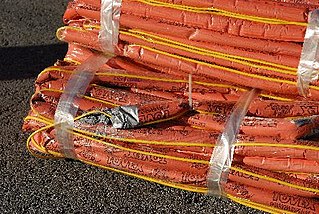Related Research Articles

Dynamite is an explosive made of nitroglycerin, sorbents, and stabilizers. It was invented by the Swedish chemist and engineer Alfred Nobel in Geesthacht, Northern Germany, and was patented in 1867. It rapidly gained wide-scale use as a more robust alternative to the traditional black powder explosives. It allows the use of nitroglycerine's favorable explosive properties while greatly reducing its risk of accidental detonation.

An explosive is a reactive substance that contains a great amount of potential energy that can produce an explosion if released suddenly, usually accompanied by the production of light, heat, sound, and pressure. An explosive charge is a measured quantity of explosive material, which may either be composed solely of one ingredient or be a mixture containing at least two substances.

Gunpowder, also commonly known as black powder to distinguish it from modern smokeless powder, is the earliest known chemical explosive. It consists of a mixture of sulfur, carbon and potassium nitrate (saltpeter). The sulfur and carbon act as fuels while the saltpeter is an oxidizer. Gunpowder has been widely used as a propellant in firearms, artillery, rocketry, and pyrotechnics, including use as a blasting agent for explosives in quarrying, mining, building pipelines and road building.

Nitroglycerin (NG), also known as trinitroglycerin (TNG), nitro, glyceryl trinitrate (GTN), or 1,2,3-trinitroxypropane, is a dense, colorless, oily, explosive liquid most commonly produced by nitrating glycerol with white fuming nitric acid under conditions appropriate to the formation of the nitric acid ester. Chemically, the substance is an organic nitrate compound rather than a nitro compound, but the traditional name is retained. Discovered in 1847 by Ascanio Sobrero, nitroglycerin has been used ever since as an active ingredient in the manufacture of explosives, namely dynamite, and as such it is employed in the construction, demolition, and mining industries. It is combined with nitrocellulose to form double-based smokeless powder, which has been used as a propellant in artillery and firearms since the 1880's.

Cordite is a family of smokeless propellants developed and produced in Britain since 1889 to replace black powder as a military firearm propellant. Like modern gunpowder, cordite is classified as a low explosive because of its slow burning rates and consequently low brisance. These produce a subsonic deflagration wave rather than the supersonic detonation wave produced by brisants, or high explosives. The hot gases produced by burning gunpowder or cordite generate sufficient pressure to propel a bullet or shell to its target, but not so quickly as to routinely destroy the barrel of the gun.

Smokeless powder is a type of propellant used in firearms and artillery that produces less smoke and less fouling when fired compared to gunpowder. The combustion products are mainly gaseous, compared to around 55% solid products for black powder. In addition, smokeless powder does not leave the thick, heavy fouling of hygroscopic material associated with black powder that causes rusting of the barrel.

Lammot du Pont I was a chemist and a key member of the du Pont family and its company in the mid-19th century.
Hercules, Inc. was a chemical and munitions manufacturing company based in Wilmington, Delaware, United States, incorporated in 1912 as the Hercules Powder Company following the breakup of the DuPont explosives monopoly by the U.S. Circuit Court in 1911. Hercules Powder Company became Hercules, Inc. in 1966, operating under this name until 2008, when it was merged into Ashland Inc.

Diethylene glycol dinitrate (DEGDN) is an explosive nitrated alcohol ester with the formula C4H8N2O7. While chemically similar to numerous other high explosives, pure diethylene glycol dinitrate is difficult to ignite or detonate. Ignition typically requires localized heating to the decomposition point unless the DEGDN is first atomized.

Tovex is a water-gel explosive composed of ammonium nitrate and methylammonium nitrate that has several advantages over traditional dynamite, including lower toxicity and safer manufacture, transport, and storage. It has thus almost entirely replaced dynamite. There are numerous versions ranging from shearing charges to aluminized common blasting agents. Tovex is used by 80% of international oil companies for seismic exploration.

Methylammonium nitrate is an explosive chemical with the molecular formula CH6N2O3, alternately CH3NH3+NO3−. It is the salt formed by the neutralization of methylamine with nitric acid. This substance is also known as methylamine nitrate and monomethylamine nitrate, not to be confused with methyl nitramine or monomethyl nitramine.

Trimethylolethane trinitrate (TMETN), also known as metriol trinitrate or nitropentaglycerin, is a nitrate ester. It is a high explosive similar to nitroglycerin. It is a transparent oily liquid, colorless to light brown. It is odorless. It is used in some solid propellants and smokeless powders as a plasticizer. Its chemical formula is CH3−C(CH2−O−NO2)3.

California Powder Works was the first American explosive powder manufacturing company west of the Rocky Mountains. When the outbreak of the Civil War cut off supplies of gunpowder to California's mining and road-building industries, a local manufacturer was needed. Originally located near Santa Cruz, California, the company was incorporated in 1861 and began manufacturing gunpowder in May 1864. For 50 years, it was a major employer in the county, employing between 150 and 275 men. The powder works was located on a flat adjacent to the San Lorenzo River, three miles upstream of Santa Cruz.
Oriental Powder Company was a gunpowder manufacturer with mills located on the Presumpscot River in Gorham and Windham, Maine. The company was one of the four largest suppliers to Union forces through the American Civil War.

Laflin & Rand Powder Company was a gunpowder and early smokeless powder manufacturer notable for producing the smokeless powder used by United States Army infantry rifles from 1896 to 1908, which included the period of development of the M1903 Springfield rifle and .30-06 Springfield cartridge.
Ball propellant is a form of nitrocellulose used in small arms cartridges. Ball propellant can be manufactured more rapidly with greater safety and less expense than extruded propellants.

IMR Legendary Powders is a line of smokeless powders which are popularly used in sporting and military/police firearm cartridges. The initials 'IMR' stand for Improved Military Rifle powder. IMR powders makes a line of various types of smokeless powder suitable for loading many cartridges for rifles, handguns, and shotguns.

The Poudrerie nationale de Vonges is a French powder mill established in 1691 in Vonges, Côte-d'Or. It manufactured explosives for use in quarries, mines and fireworks. During World War I (1914–18) it manufactured munitions. It expanded after the war, producing explosives for civil use. During World War II (1939–45) production was scaled back drastically, but expanded again after the war. The powder mill was fully privatized in 2008.

Apache Nitrogen Products began in 1920 as an American manufacturer of nitroglycerin-based explosives (dynamite) for the mining industry and other regional users of dynamite. It occupies a historic location in Cochise County, Arizona and is one of its largest employers. The company changed its name to Apache Nitrogen Products in 1990.
The United States Cartridge Company explosion occurred on July 29, 1903, in present-day Lowell, Massachusetts. The explosion of two buildings used to store dynamite and gunpowder killed 22 people and destroyed 13 homes.
References
- ↑ Virginia. Dept. of Agriculture and Commerce (1922). Yearbook 1922. Virginia Department of Agriculture and Commerce. p. 125. Retrieved December 16, 2012.
- ↑ Wool Production, Extension Bulletin #136(Issues 135-184). State College of Washington. April 1926. p. 74.
Pyrotol is a mixture of 60% smokeless powder, 34% sodium nitrate and 6% of 40% nitroglycerin dynamite.
- ↑ Buhk, Tobin T. (2011). True Crime: Michigan: The State's Most Notorious Criminal Cases. Stackpole Books. ISBN 978-0-8117-0713-8 . Retrieved December 16, 2012.
- ↑ Gado, Mark. "Hell Comes to Bath". crimelibrary. Archived from the original on July 23, 2012. Retrieved December 16, 2012.
- ↑ Schechter, Harold (2012). Psycho USA: Famous American Killers You Never Heard Of. Random House Digital, Inc. pp. 277–278. ISBN 978-0-345-52448-5.
- ↑ "Heavy Orders Cut Supply of Pyrtol". Granite Falls Record (Newspaper Archive of Granite Falls Historical Society, Granite Falls, Washington). September 30, 1927. Retrieved December 16, 2012.
- ↑ "Report - United States. Bureau of Public Roads - Google Books". 1923. Retrieved 2022-08-19.
- ↑ Seitz, Charles E. (1925). "Project No. 10 – Land Clearing". Virginia Tech. hdl:10919/90121.